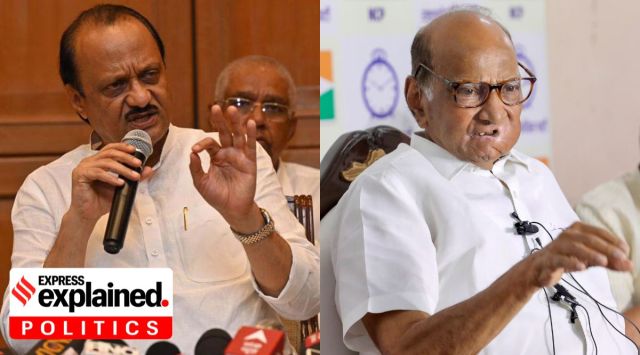NCP leadership tussle between Ajit Pawar and Sharad Pawar: How EC resolves these disputes
Splits in India’s political parties, over issues of leadership, are not uncommon. Here is what the Election Commission relies on to make its decision.
 NCP leaders Sharad Pawar (right) and Ajit Pawar (left). (Express photo)
NCP leaders Sharad Pawar (right) and Ajit Pawar (left). (Express photo) After being sworn-in as the Maharashtra Deputy Chief Minister on Sunday (July 2), Nationalist Congress Party (NCP) leader Ajit Pawar removed his uncle, Sharad Pawar, from the post of party president, and wrote to the Election Commission (EC) seeking recognition of his faction as the real NCP.
As The Indian Express reported, both Ajit Pawar and Sharad Pawar later held separate meetings on Wednesday. While at least 29 of the party’s 53 MLAs were at the former’s meeting and signed affidavits confirming their allegiance to him, 16 MLAs attended the latter’s meeting. At Ajit’s swearing-in on Sunday, 16 or 17 MLAs were present.
Splits in India’s political parties, over issues of leadership, are not uncommon. Just this year, the EC decided on a dispute among the Shiv Sena, giving the official name of the party, as well as the ‘bow and arrow’ symbol, to the Eknath Shinde faction.
How does the EC decide on splits within parties?
On the question of a split in a political party outside the legislature, Para 15 of the Symbols Order, 1968, states: “When the Commission is satisfied…that there are rival sections or groups of a recognised political party each of whom claims to be that party the Commission may, after taking into account all the available facts and circumstances of the case and hearing (their) representatives…decide that one such rival section or group or none of such rival sections or groups is that recognised political party and the decision of the Commission shall be binding on all such rival sections or groups.”
This applies to disputes in recognised national and state parties (like the Shiv Sena). For splits in registered but unrecognised parties, the ECI usually advises the warring factions to resolve their differences internally or to approach the court.
The first case to be decided under the 1968 Order was the first split in the Indian National Congress in 1969. After the party old guard led by K Kamaraj, Neelam Sanjiva Reddy, S Nijalingappa, and Atulya Ghosh, known as the Syndicate, expelled Indira Gandhi from the Congress, and the party split into the “old” Congress (O) led by Nijalingappa and the “new” Congress (J) led by Indira. The “old” Congress retained the party’s official symbol of a pair of bullocks carrying a yoke; the breakaway faction was given the symbol of a cow with its calf.
What happened before 1968?
Before 1968, the EC issued notifications and executive orders under the Conduct of Election Rules, 1961.
The most high-profile split of a party before 1968 was that of the Communist Party of India (CPI) in 1964. A breakaway group approached the ECI in December 1964, seeking recognition as CPI (Marxist). They provided a list of MPs and MLAs of Andhra Pradesh, Kerala and West Bengal who supported them.
The ECI recognised the faction as CPI(M) after it found that the votes secured by the MPs and MLAs supporting the breakaway group added up to a significant amount in three states.
Is there a way other than the test of majority to resolve a symbol dispute?
In almost all such disputes so far, a clear majority of party delegates/office bearers, MPs and MLAs have supported one of the factions. In the case of the Shiv Sena earlier this year, the majority of the party’s elected representatives switched over to Shinde’s side.
Whenever the ECI could not test the strength of rival groups based on support within the party organisation (because of disputes regarding the list of office bearers), it has sought to fall back on testing the majority only among elected MPs and MLAs.
And what happens to the group that doesn’t get the parent party’s symbol?
In the case of the first Congress split, the ECI recognised both the Congress (O) and the breakaway faction, whose president was Jagjivan Ram. The Congress (O) had a substantial presence in some states and satisfied the criteria fixed for recognition of parties under Paras 6 and 7 of the Symbols Order.
This principle was followed up to 1997. However, things changed when the ECI dealt with the splits in the Congress, Janata Dal, etc. that led to the creation of Sukh Ram and Anil Sharma’s Himachal Vikas Congress, Nipamacha Singh’s Manipur State Congress, Mamata Banerjee’s West Bengal Trinamool Congress, Lalu Prasad’s RJD, Naveen Patnaik’s Biju Janata Dal, etc.
The ECI felt that merely having MPs and MLAs is not enough, as the elected representatives had fought and won polls on tickets of their parent (undivided) parties. It introduced a new rule under which the splinter group — other than the group that got the symbol — had to register itself as a separate party, and could lay claim to national or state party status only on the basis of its performance in state or central elections after registration.
- 01
- 02
- 03
- 04
- 05






































